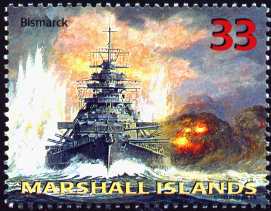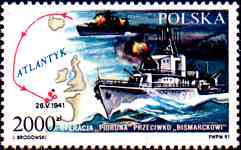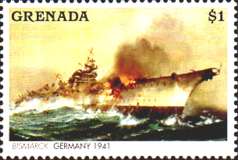|

|
Maritime Topics On Stamps
Battleship 'Bismarck'!
|
The specifications of the battleship 'Bismarck':
- built from 1936 - 1940 at Blohm & Voss dock yard, Hamburg
- L * B * T 823.5 * 118 * 33 feet
- 41.700 tdw standard, 50.900 tdw in the employment
- Engine power 150.170 WPS
- 2 rudders, 3 screws
- Speed 30,1 knots
- Armament 8 * 38 cm, 12 * 15 cm
- Armament air defense 16 * 10,5 cm, 12 * 2 cm
- Armoring waterline 320 mm, Deck 120 mm
- Catapult for four water airplanes
- Crew 2065 Mann, 2206 men including the staff of admiral Luetjens during the first and last voyage
|

'Bismarck'
|

|
After the first day of commission in August 1940 the ship was tested in the
Baltic Sea and the crew was trained.
On May 19th, 1941 the battleship 'Bismarck' left Gotenhafen, accompanied by
the heavy cruiser 'Prinz Eugen'. The first voyage was code named 'Rheinübung',
which translates to 'Rhine exercise'. Its order to attack and disrupt escorts and
convoys of the British in the North Atlantic. To reach the area of operation the
German ships had to break through the English blockade of the North Sea.
|

|
On this map you can see the course of the 'Bismarck' drawn in red from the start
in Gotenhafen to the destruction in the Biskaya. The courses of the different
British ships are represented by the dotted lines. Enormous secrecy efforts
covered the departure, but the ship was recognized by a Swedish aircraft
carrier and reported to London.
The secret breakthrough attempt into the Atlantic had failed. As you can see on
the map, the 'Bismarck' and 'Prinz Eugen' entered the secure fjord of Bergen to
replenish fuel. Then the ships headed north for the Denmark Strait.
|

|

| |
HMS 'Norfolk' |
HMS 'Hood'
| |
Meanwhile the British dispatched their home fleet, anchored at Scapa Flow,
against the German breaktrough.
The heavy cruisers 'Norfolk' and 'Suffolk' patrolled the Denmark Strait,
the cruisers 'Birmingham' and 'Manchester' covered the area between
Iceland and the Faroeer Islands. The battleships 'Hood' and 'Prince of Wales'
left Scapa Flow for Iceland.
In the evening of the 23th of May, 1941 the German formation was discovered
by the 'Suffolk' and 'Norfolk' in the Denmark Strait. A short shooting resulted
with neither side scoring any hits. The English evaded and pursued the German
ships. Several attempts to shake off the Englishmen by sudden course changes
failed, since the Englishmen had very good long-range radar devices. And the
two battleships 'Hood' and 'Prince of Wales' approached at full speed.
|

| |
'Prince of Wales' and 'Hood' in combat with 'Bismarck'
| |
At dawn 24th of May the 'Bismarck' and 'Prinz Eugen' clashed with the 'Hood'
and 'Prince of Wales'. The fourth salvo of the 'Bismarck' proved deadly for
the 'Hood'. The shells pierced the deck armor and probably detonated in an
ammunition chamber. The battleship exploded and broke into two parts. She
vanishished within seconds (see stamp above). The 'Prince of Wales', which
also had received seven hits, immediately tried to escape. The Germans let
her go. Only three of the 1419 strong crew of the 'Hood' survived the
explosion. They drifted in a rescue raft and were saved by the destroyer
'Electra'.
|

|
The 'Bismarck' had also received three dire hits. One grenade had hit the ship
above the waterline at the bow. Nevertheless water flowed in because of the
bow wave. Another grenade pierced the trunk below the belt armor and caused
flooding of the front turbine power station. Access to the front fuel tanks
was disrupted. The 'Bismarck' dragged a long oil track in the wake behind her,
which could be easily spotted by the reconnaissance aircraft.
| |
The 'Bismarck' fires a broadside.
| |
The fuel situation on board the 'Bismarck' became critical and cruising speed
had to be reduced to 24 knots. Admiral Luetjens dismissed the 'Prinz Eugen'
and set course for the German naval bases in France.
|

HMS 'Victorious' |

HMS 'Renown'
| |
The British hunt for the 'Bismarck' was on. The 'Suffolk', 'Norfolk' and 'Prince
of Wales' followed her oily wake. From the west the battleships 'King George V',
'Repulse', 'Rodney' and the aircraft carrier 'Victorious' were approaching. From
the south the 'Force H' set course for the Biscaya. This task force consisted of the
aircraft carrier 'Ark Royal', the battle cruiser 'Renown', the cruiser 'Sheffield'
and six destroyers.
Close to midnight, eight Swordfish double-deckers of the carrier 'Victoriuos'
attacked the 'Bismarck' with their torpedoes. One of them hit home but only
caused minor damage.
|
|
On the 25th of May around three o'clock a.m. the 'Bismarck' drove a hook and
crossed her own wake. The British lost radar contact and had no clue which
direction the 'Bismarck' was heading for. But 30 hours later she was discovered
by coincidence. A Catalina seaplane spotted the battleship and transmitted her
position to all British units. The hunt continued, with the 'Bismarck' still
approximatley 700 nm off Brest.
|

Catalina seaplane discovers 'Bismarck'
|

HMS 'Ark Royal'
|
At the time of the rediscovery the 'Ark Royal' was only 60 nm away from
the position of the 'Bismarck'. The aircraft carrier started two waves
of Swordfish airplanes carrying torpedoes. Some machines of the first
wave attacked the British 'Sheffield' by mistake, but no harm was done.
The other machines flew extremely low to the wildly firing 'Bismarck'.
|

Swordfish airplanes attack the 'Bismarck' with torpedoes.
| |
Despite several emergency evasive maneuvers two torpedoes hit amidships and
aft. The rudder of the 'Bismarck' was stuck at 12 degrees port. The commander
tried to steer the ship with the three screws, but failed. The speed decreased
to seven knots, and the battleship headed erratic snake movements to the northwest.
Now the 'Bismarck' could not escape from its pursuers any longer. Additionally
the wind increased to storm strength.
|
|
Four British and a Polish destroyer (the 'Piorun', see stamp) were in the
area and headed for the 'Bismarck'. They delivered their torpedoes and
disappeared fast enough to escape the return artillery barrage, although
no torpedo hit.
|

Polish destroyer ' 'Piorun'
|

HMS 'King George V'

HMS 'Rodney'
|
| |
On the 27th of May, 1941 at 08:48 the last battle of the 'Bismarck' began.
The two British battleships 'King George V' and 'Rodney' and the heavy
cruisers 'Norfolk' and 'Dorsetshire' had arrived and opened fire. The 'Bismarck'
was heavily hit, many fires erupted developed, and one turret after another
failed. Around 09:31 the 'Bismarck' fired her last salvo, then her cannons
grew silent. The Englishmen continued to fire for 51 more minutes up to 10:22 as they
had order to sink the 'Bismarck'. Then the 'Dorsetshire' fired two torpedoes but to
no avail. The 'Bismarck' refused to sink, although she was a burning wreck.
Apparently the battleship had suffered only minor damage below the waterline.
Nevertheless she went down around 10:39 by self sinking. The Germans had opened
the sea valves and detonated an explosive charge.
|

shot-up 'Bismarck'
|

HMS 'Dorsetshire' |
|
Everybody on the 'Bismarck', who could still move, jumped into the oily water. The
British battleships left the area because of lack of fuel. The 'Dorsetshire' and
the cruiser 'Maori' turned and tried to rescue some of the swimmers by throwing
ropes and cordage over the sides. But halfway through the rescue attempt a
submarine alarm was sounded on the British ships. They drove off leaving behind hundreds
of despairing Germans still swimming in the water.
In the end 110 men were saved by the British ships. Three were picked-up one
day later by the German submarine U-47 and two by the weather ship 'Sachsenwald'.
2106 men of the 'Bismarck' were never recovered.
For the pursuit and destruction of the 'Bismarck' the Englishmen had utilized
five battleships, three heavy cruisers, two aircraft carriers, 13 cruisers,
33 destroyers and eight submarines.
|

'Argo' over the wreck of 'Bismarck'
|
In 1988 the American sea geologist Robert D. Ballard started a search for the
'Bismarck' using the camera dragging carriage 'Argo'. They failed and tried again
in 1989 with the research ship 'Star Hercules'. On the 8th of June, 1989 they
discovered the wreck of the 'Bismarck' on their screens. The ship lies in 4.790 m
(15,715 feet) depth at the edge of a submerged volcano upright on her keel.
Where the heavy turrets stood, large, round holes are gaping (see the stamp to the left).
The swastika on the nose of the ship was painted over during the eight day voyage.
Time and sea water brought it back.
|

| |
After the evaluation of photos and tape Robert Ballard came to the following
conclusion: When the 'Bismarck' capsized, the damaged stern broke off and the
large turrets were torn from the ship by the force of their own weight. Now,
fully flooded, the 'Bismarck' sank and turned to even keel.
The ship impacted on the slope of an underwater mountain and slid down with an
avalanche of sediments. The trunk does not exhibit any signs of implosions as
seen on the stern of the 'Titanic'. That means that outside and interior water
pressure corresponded - a sign for a controlled flooding and thus for self sinking.
|
|
In May 2002 the film director James Cameron, who had directed among other things
the most well-known Titanic film, started an expedition to the 'Bismarck' to shoot
a 'documentary film'. He hired a Russian research ship and dived with the two
submersibles 'Mir 1' and 'Mir 2'. They utilized a robot probe (ROV - remote
operand vehicle), and they steered the robot into several openings of the
'Bismarck'. Cameron was able to shoot some spectacular photographs of the
destroyed rudder and several different interiors. The team counted only four
direct hits in the hull armor of the 'Bismarck', but discovered long tears at
the bottom. Cameron confirmed that all signs indicated that the ship was sunk
by its crew.
|

Russian submersibles 'Mir'
| |
The Englishmen reported that all-in-all 2,876 shells were fired at the
'Bismarck', 719 alone from the heavy artillery consisting of the 40cm and 37cm
cannons of the 'Rodney' and the 'King George V'. But the ships drove
so closely to the 'Bismarck', allegedly up to three nautical miles, that
the main guns could not be lowered enough to hit the trunk.
|

The 'Bismarck' with camouflaging tires and wrong bow wave,
they were re-painted grey in Norway.
|
Despite the self sinking activities of the Germans, the 'Bismarck'
would have sunk sooner or later for sure.
The film team brought a memorial sign down to the 'Bismarck',
in rememberance of the deceased German and British naval soldiers.
Unfortunately the documentary film of Cameron is very theatrical
and emotional.
|
|
Otto Fürst von Bismarck lived from 1815 to 1898. He was a delegate, diplomat, envoy
and the Prime Minister of Prussia. After victorious campaigns against Denmark, Austria and
France he was regarded as one of the architects of the German Reich (founded in 1871)
and acted as chancellor up to his dismissal in 1890.
|
© 1998 - 2004 Bjoern Moritz, all rights reserved.
|